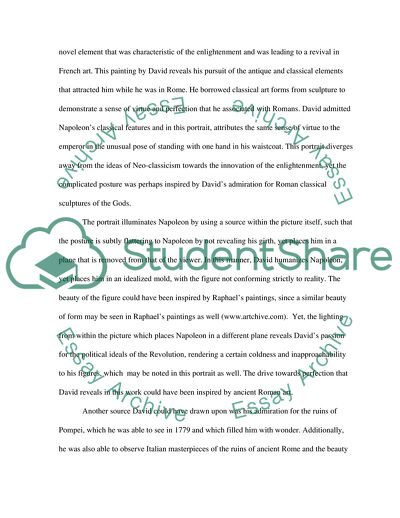
- Home
- Free Samples
- Premium Essays
- Editing Services
- Extra Tools
- Essay Writing Help
- About Us
- Studentshare
- Subjects
- Miscellaneous
- What sources did Jacques Louis David draw upon for his portraits of napoleon
What sources did Jacques Louis David draw upon for his portraits of napoleon - Essay Example

- Subject: Miscellaneous
- Type: Essay
- Level: Undergraduate
- Pages: 4 (1000 words)
- Downloads: 0
- Author: hanewalker
Extract of sample "What sources did Jacques Louis David draw upon for his portraits of napoleon"
This portrait is a variation of the general paintings of the day that showed ruling figures in their ceremonial attire. This was the result of David’s choice of “innovation and transformation as the essential principles of his art” which was concurrent with the tide of enlightenment that was sweeping over the land and thereby constitutes David’s “modernity.” (Johnson 1993:3-4). Roberts (1989) has explained how some of David’s images are drawn from the Rousseauian ideas of transparency, increasingly moving away from rigid art forms to the novel element that was characteristic of the enlightenment and was leading to a revival in French art.
This painting by David reveals his pursuit of the antique and classical elements that attracted him while he was in Rome. He borrowed classical art forms from sculpture to demonstrate a sense of virtue and perfection that he associated with Romans. David admitted Napoleon’s classical features and in this portrait, attributes the same sense of virtue to the emperor in the unusual pose of standing with one hand in his waistcoat. This portrait diverges away from the ideas of Neo-classicism towards the innovation of the enlightenment, yet the complicated posture was perhaps inspired by David’s admiration for Roman classical sculptures of the Gods.
The portrait illuminates Napoleon by using a source within the picture itself, such that the posture is subtly flattering to Napoleon by not revealing his girth, yet places him in a plane that is removed from that of the viewer. In this manner, David humanizes Napoleon, yet places him in an idealized mold, with the figure not conforming strictly to reality. The beauty of the figure could have been inspired by Raphael’s paintings, since a similar beauty of form may be seen in Raphael’s paintings as well (www.artchive.com).
Yet, the lighting from within the picture which places Napoleon in a different plane reveals David’s passion for
...Download file to see next pages Read MoreCHECK THESE SAMPLES OF What sources did Jacques Louis David draw upon for his portraits of napoleon
Jacque-Louis David Compared to Sandow Birk
Revolutions Are an Indication of the Decadence of a System
Works of Jacques Louis David and Damier
To what extent does the work of Jaques Louis David change during the French Revolution
Napoleonic paintings
The Coronation of Emperor Napoleon I
Louis Napoleon Bonaparte
Empire to Exile: A Jacques Louis' View of Art

- TERMS & CONDITIONS
- PRIVACY POLICY
- COOKIES POLICY